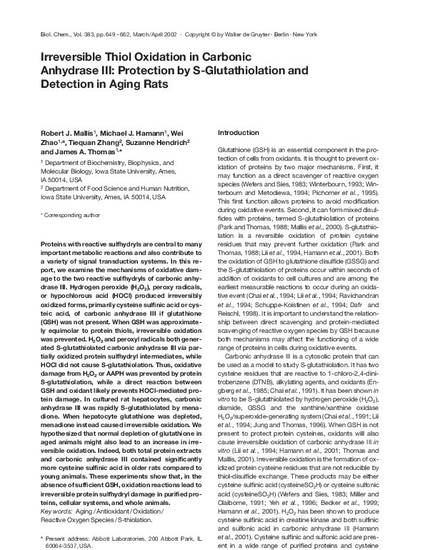
Proteins with reactive sulfhydryls are central to many important metabolic reactions and also contribute to a variety of signal transduction systems. In this re- port, we examine the mechanisms of oxidative dam- age to the two reactive sulfhydryls of carbonic anhy- drase III. Hydrogen peroxide (H2O2), peroxy radicals, or hypochlorous acid (HOCl) produced irreversibly oxidized forms, primarily cysteine sulfinic acid or cys- teic acid, of carbonic anhydrase III if glutathione (GSH) was not present. When GSH was approximate- ly equimolar to protein thiols, irreversible oxidation was prevented. H2O2 and peroxyl radicals both gener- ated S-glutathiolated carbonic anhydrase III via par- tially oxidized protein sulfhydryl intermediates, while HOCl did not cause S-glutathiolation. Thus, oxidative damage from H2O2 or AAPH was prevented by protein S-glutathiolation, while a direct reaction between GSH and oxidant likely prevents HOCl-mediated pro- tein damage. In cultured rat hepatocytes, carbonic anhydrase III was rapidly S-glutathiolated by mena- dione. When hepatocyte glutathione was depleted, menadione instead caused irreversible oxidation. We hypothesized that normal depletion of glutathione in aged animals might also lead to an increase in irre- versible oxidation. Indeed, both total protein extracts and carbonic anhydrase III contained significantly more cysteine sulfinic acid in older rats compared to young animals. These experiments show that, in the absence of sufficient GSH, oxidation reactions lead to irreversible protein sulfhydryl damage in purified pro- teins, cellular systems, and whole animals.
Available at: http://works.bepress.com/suzanne_hendrich/17/

This article is from Biological Chemistry, 383(3-4) 2002: 649-662. doi: 10.1515/BC.2002.067. Posted with permission. The final publication is available at www.degruyter.com.